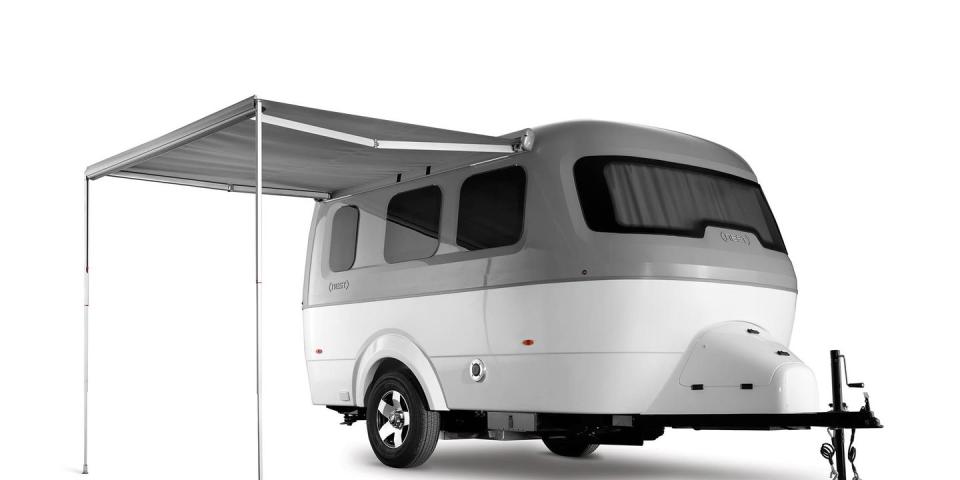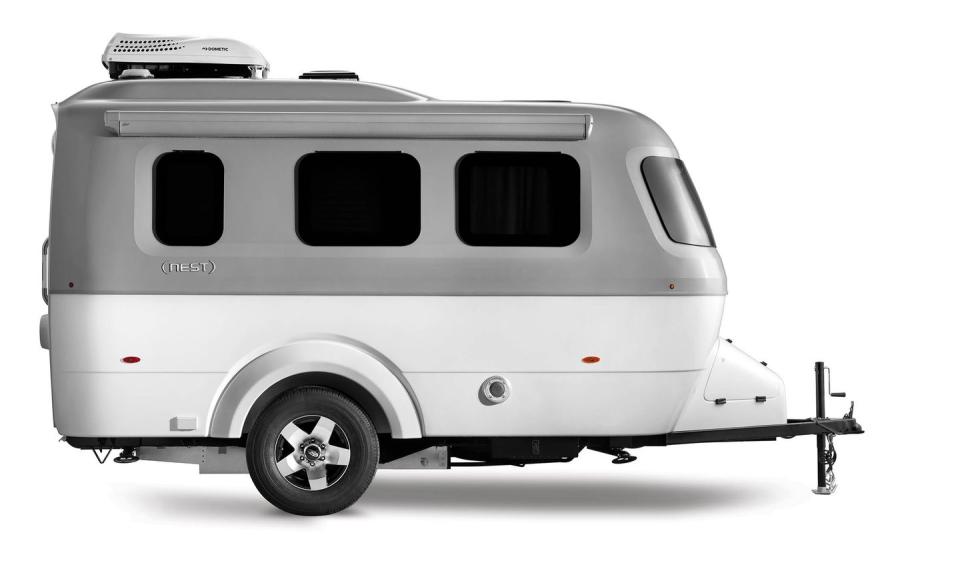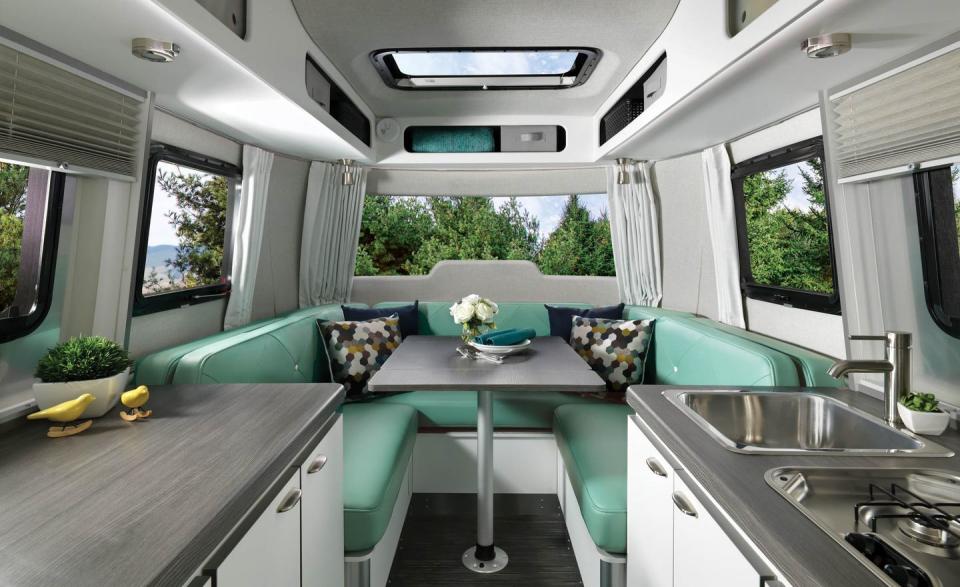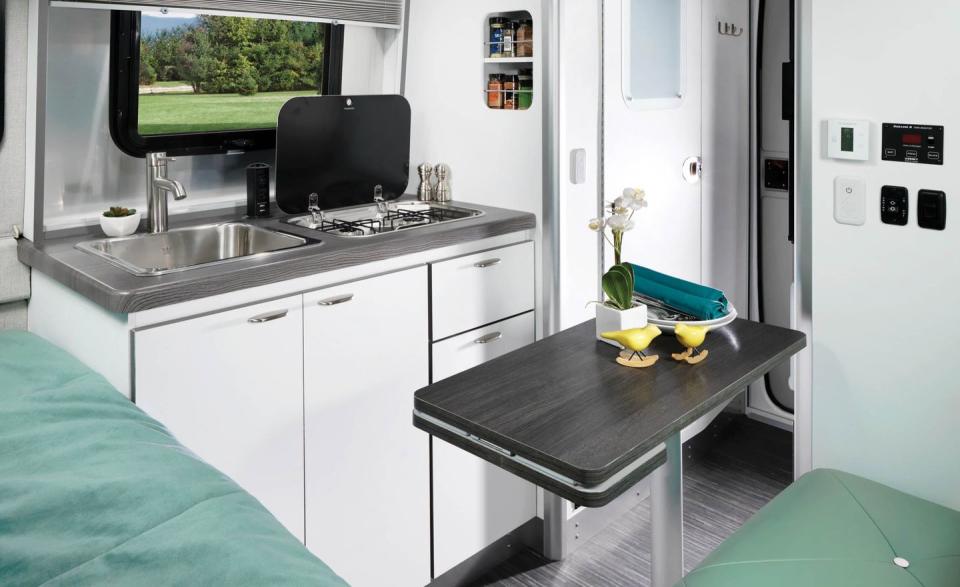The Airstream Nest Trades Aluminum for Fiberglass

Airstream is no stranger to building small campers. The Ohio-based maker of recreational vehicles first tried its hand in the segment in 1951 with the 15-foot-long Cruisette, which offered the aluminum-bodied looks of Airstream’s larger travel trailers in a condensed package.
Nearly seven decades later, the Cruisette’s combination of chic styling and compact proportions continues to influence Airstream’s littlest travel trailers, the latest of which is the 16-foot, seven-inch Nest. Slotting between the entry-level Basecamp and the pricier Sport in the Airstream lineup, the Nest trades the art-deco design of its aluminum-bodied siblings for modern wares made of fiberglass.
No Lightweight
At 3400 pounds, the Nest’s mass is between 540 and 815 pounds greater than its similarly sized stablemates. Such is the cost of vanity.
While Airstream campers have never been short on style, the Nest’s distinct design provides the Lilliputian camper with panache unlike anything else on the road today. Motorists gawked and stared at the gray and white camper as though it were an exotic sports car, as we towed the Nest more than 150 miles from our office in southeastern Michigan to the campground at Grand Haven State Park on the state’s west coast.
Despite its relative heft, the Nest proved easy to ferry about. Neither our long-term Audi Q7 nor Honda Ridgeline, both with all-wheel drive, struggled to reach or maintain highway speeds with the fiberglass-bodied trailer in tow. Nor did the nearly 10-foot-tall Nest feel particularly bulky or cumbersome when navigating crowded parking lots or twisting two-lane roads. That being said, our 333-hp Q7 and 280-hp Ridgeline are rated to tow 7700 and 5000 pounds respectively, and both are substantially sized vehicles on their own. Towing a Nest with a vehicle that offers less power, a lower towing capacity, and a smaller footprint may make for a different behind-the-wheel experience.
Look at Me Now
The Nest’s contemporary exterior style extends to its interior, with its Scandinavian-style simplicity. Two interior floorplans are available, both of which sleep two. One features a fixed queen-size bed at the front of the cabin and a small dinette, while the second floorplan replaces the permanent bed with a large U-shaped dinette that converts into a bed and the small dinette with additional countertop and storage space. Given our struggle to successfully convert this Nest’s dinette into a sleeping space, we’d be inclined to opt for the fixed-bed floorplan.
We found the Nest a comfortable and cozy place to hang out. A multitude of windows and a skylight brought plenty of natural light into the camper, while a myriad of plugs and USB ports ensured our mobile devices didn’t go uncharged. Other niceties include a power-operated exterior awning, a full “wet” bathroom, a roof-mounted air-conditioning system, a propane-fueled two-burner stove, a stainless-steel sink, a microwave, and a refrigerator.
Still, the Nest is a small thing, and its interior reflects this. Although its airy atmosphere prevents the Nest from feeling cramped, its compact quarters make the Nest a tool best used for temporary getaways. Long-haul travelers and consumers looking to participate in the tiny-house movement will surely be better served by a larger camper.
Numbers Game
With a base price of $47,234, the Nest is a decidedly pricey purchase. Consider that the 18-foot, four-inch Winnebago Minnie Drop starts at less than half the price of the Nest. Meanwhile, Airstream’s own Basecamp travel trailer has a starting price nearly $10,000 less than that of the Nest. It seems that cost-conscious consumers willing to sacrifice the Nest’s charismatic aesthetics would be wise to look at less expensive alternatives.
Those with the means, though, will find the Nest offers a fine combination of towing ease, comfortable accommodations, and general charm. Like opting for a luxury car over a mainstream model, the Nest has an unquantifiable appeal that simply makes it feel special.
('You Might Also Like',)

 Yahoo Finance
Yahoo Finance 



